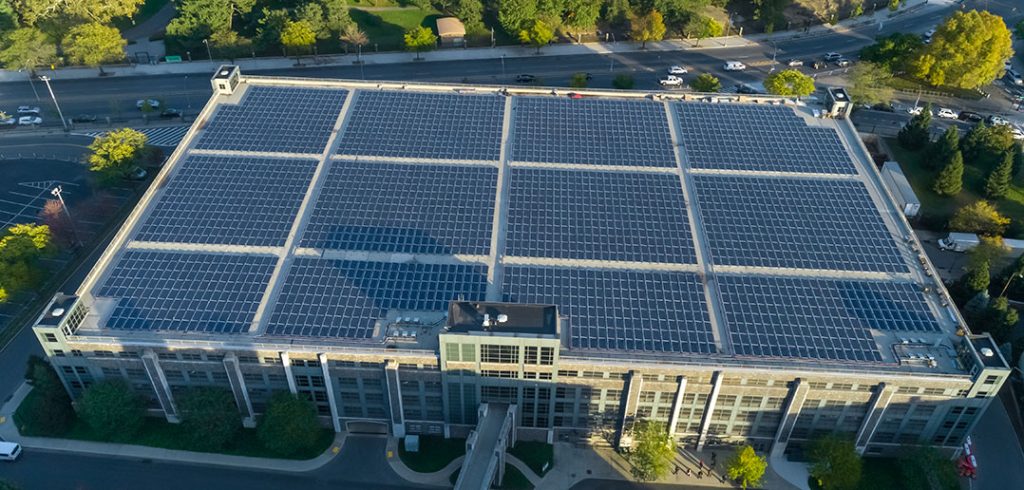That’s the message of the University’s latest climate action plan annual report.
“As a University, we’re working toward a more sustainable world and doing the part that we can do here, both in the physical plant, as well as the academic realm and the relationships to the community,” said Marco Valera, vice president of administration, who issues the report annually as part of the University’s commitment to sustainability.
The latest report details not only strides that the department of facilities made in 2021—such as converting 90% of the lights in the Rose Hill Gym to LEDs—but also Fordham’s plans for the future and the efforts it has made since 2007, when the University joined the NYC Carbon Challenge and committed to reduce greenhouse gas emissions by 30% by 2017. Fordham extended that commitment in 2017 by pledging a 40% reduction by 2030; to date, Fordham has reduced its carbon emissions intensity by 31.77% and its energy consumption by 16.64% from its 2005 base-year levels.
“We think we’re in a good place; we’re getting closer to our 40% target to reduce those gases by 2030. We continue to roll out projects that will achieve that,” he said, noting that he’s working in conjunction with Fordham’s Center for Community Engaged Learning, which just issued the University’s Laudato Si’ action plan. That plan, he said, covers the broader sustainability efforts of the Fordham community, while his plan focuses primarily on the bricks-and-mortar realm.
Some facilities projects, such as the installation of 2,790 solar panels on the Rose Hill parking garage, are well known, but other less-obvious ones detailed in the report are no less important. In 2015, for instance, Fordham completed two strategic Light Emitting Diode (LED) re-lamping initiatives on the Rose Hill and Lincoln Center campuses, thus conserving 712,000 kilowatts of energy annually, and installed its first fuel cell powering the Walsh Family Library, with several more similar installations planned for the Rose Hill campus.
In addition to adding space to the University’s footprint, new structures on campus are being constructed to achieve—at a minimum—the U.S. Green Building Council’s Leadership in Energy and Environmental Design (LEED) new construction Silver rating. The Joseph M. McShane, S.J. Campus Center, which was dedicated in April, was designed to follow the energy efficiency standard known as passive house. It features triple-glazed windows; automatic lighting controls; LED lights; recycled materials; and heat recovery mechanical ventilation wheels, which reuse the building’s heat in cooler months. When the final phase of construction is complete, the center’s Marketplace dining space will also be fully renovated and will include a new food composting initiative which is expected to reduce green house emissions by 876,000 pounds each year.
When it comes to future projects, Valera said that he expects that work on a new solar canopy array generating nearly one megawatt of electricity at the Westchester campus parking lot will begin within a year. The University is also committed to connecting one or several buildings on the Rose Hill campus to geothermal power within the next five years. In the meantime, projects like the replacement of lights in the Rose Hill Gym with LEDs and installation of new fuel cell plants will continue.
The Facilities Department is also conducting audits of the University’s most energy-intensive buildings, such as the Walsh Family Library, to make sure all their systems are in tip-top shape.
“Over time, building systems can have equipment breakdowns that you just don’t see. So, we’ll do an energy study on each major building and then out of that will come small projects that can be done. It can be anything from replacing elevator motors with more efficient motors to replacing small boilers,” Valera said.
“It’s just like you would do for a house. If you were intending to live in it for 100 years, you would want to go geothermal, you would want to get solar panels on the roof, and you might think about reinsulating your attic and exteriors a little better.”
Valera said the spike in energy costs triggered by the war in Ukraine has made the University’s past investments in energy efficiency even more fruitful. At Fordham’s London campus, the price of natural gas shot up 500%, while in the United States, the cost of electricity has risen 40%. At that rate, it becomes much more economical to pay the upfront costs of expensive equipment upgrades.
“We have a rule of thumb that we try to do projects that have a five-or-less-year return on investment first. It’s probably half that now,” he said.
“We’re getting a huge increase in utility costs, and so that’s going to drive up the energy savings from replacing legacy equipment that’s inefficient.”

